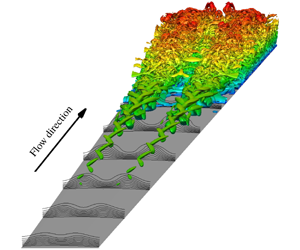Article contents
Mechanism for frustum transition over blunt cones at hypersonic speeds
Published online by Cambridge University Press: 11 May 2020
Abstract

Numerical and experimental studies have demonstrated laminar–turbulent transition in hypersonic boundary layers over sharp cones via the modal growth of planar Mack-mode instabilities. However, due to the strong reduction in Mack-mode growth at higher nose bluntness values, the mechanisms underlying the observed onset of transition over the cone frustum are currently unknown. Linear non-modal growth analysis has shown that both planar and oblique travelling disturbances that peak within the entropy layer experience appreciable energy amplification for moderate to large nose bluntness. However, due to their weak signature within the boundary-layer region, the route to transition onset via non-modal growth of travelling disturbances remains unclear. Nonlinear parabolized stability equations (NPSE) and direct numerical simulations (DNS) are used to identify a potential mechanism for transition over a 7-degree blunt cone that was tested in the AFRL Mach-6 high-Reynolds-number facility. Specifically, computations are conducted to study the nonlinear development of a pair of oblique, unsteady non-modal disturbances in the regime of moderately blunt nose tips. Excellent agreement was demonstrated between the NPSE and DNS predictions. Results reveal that, even though the linear non-modal disturbances are primarily concentrated outside the boundary layer, their nonlinear interaction can generate stationary streaks that penetrate and amplify within the boundary layer, eventually inducing the onset of transition via the breakdown of these streaks. The results indicate that a pair of oblique, controlled non-modal disturbances can produce transition at the location measured in the experiment when their initial amplitude is chosen to be approximately 0.15 % of the free-stream velocity.
Information
- Type
- JFM Papers
- Information
- Creative Commons
- This is a work of the US Government and is not subject to copyright protection within the United States.
- Copyright
- © National Institute of Aerospace Associates and United States Government as Represented by the Administrator of the National Aeronautics and Space Administration, 2020. Published by Cambridge University Press
References
- 59
- Cited by

